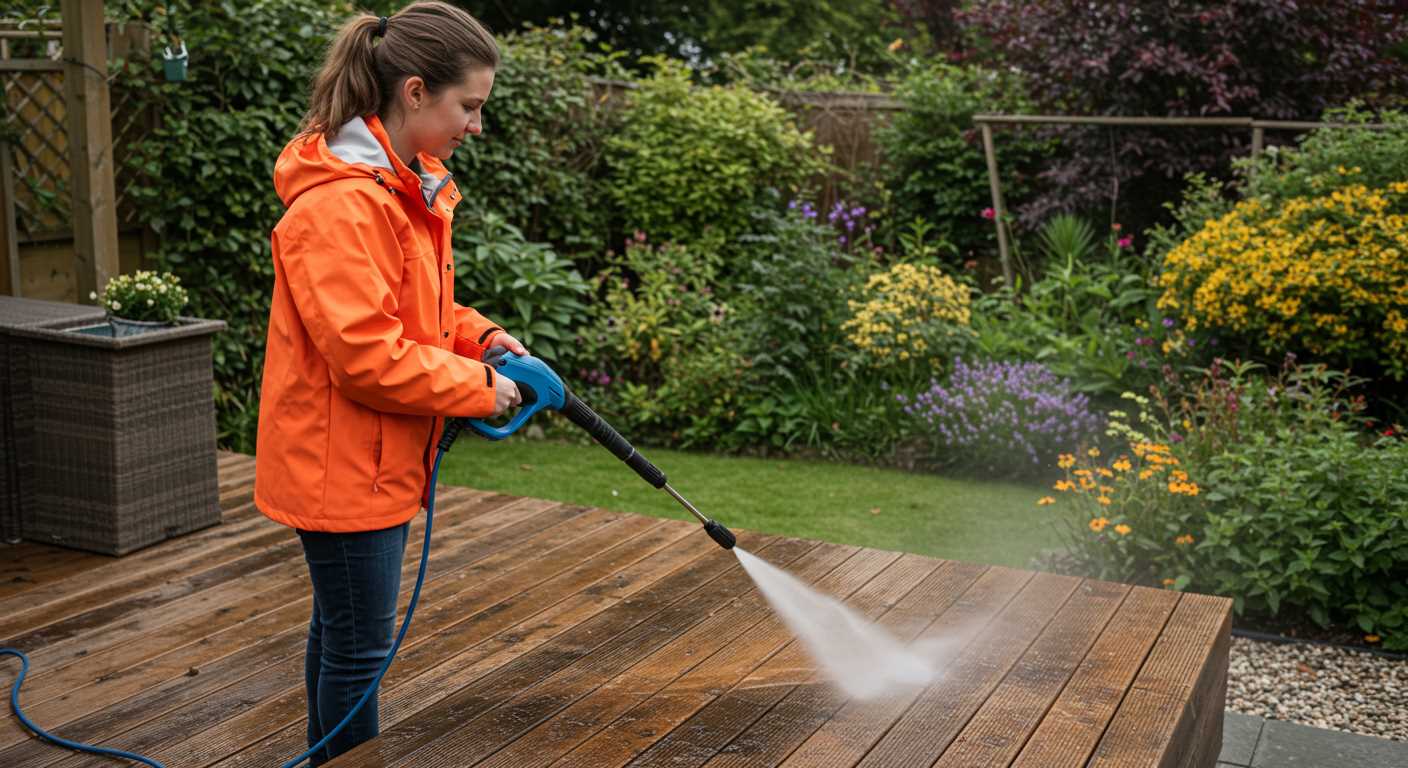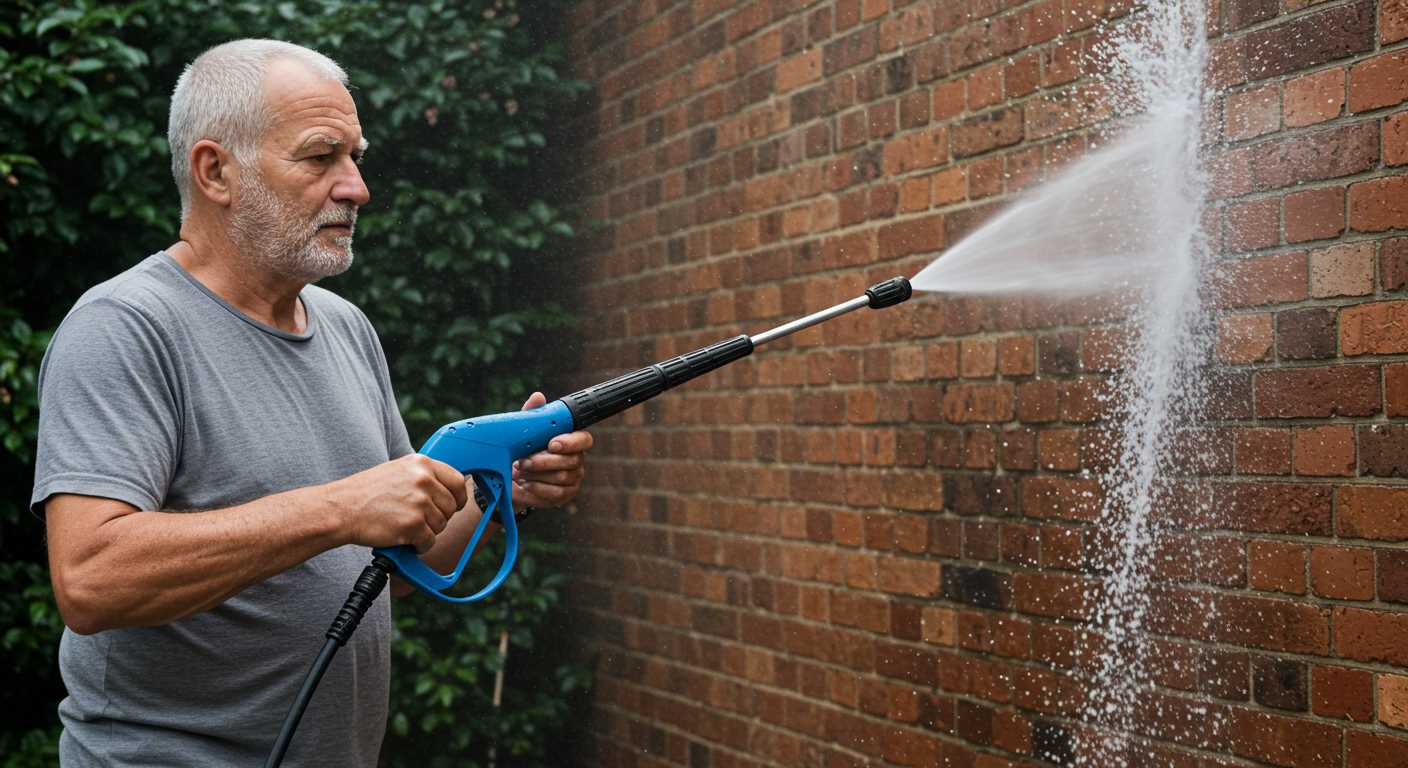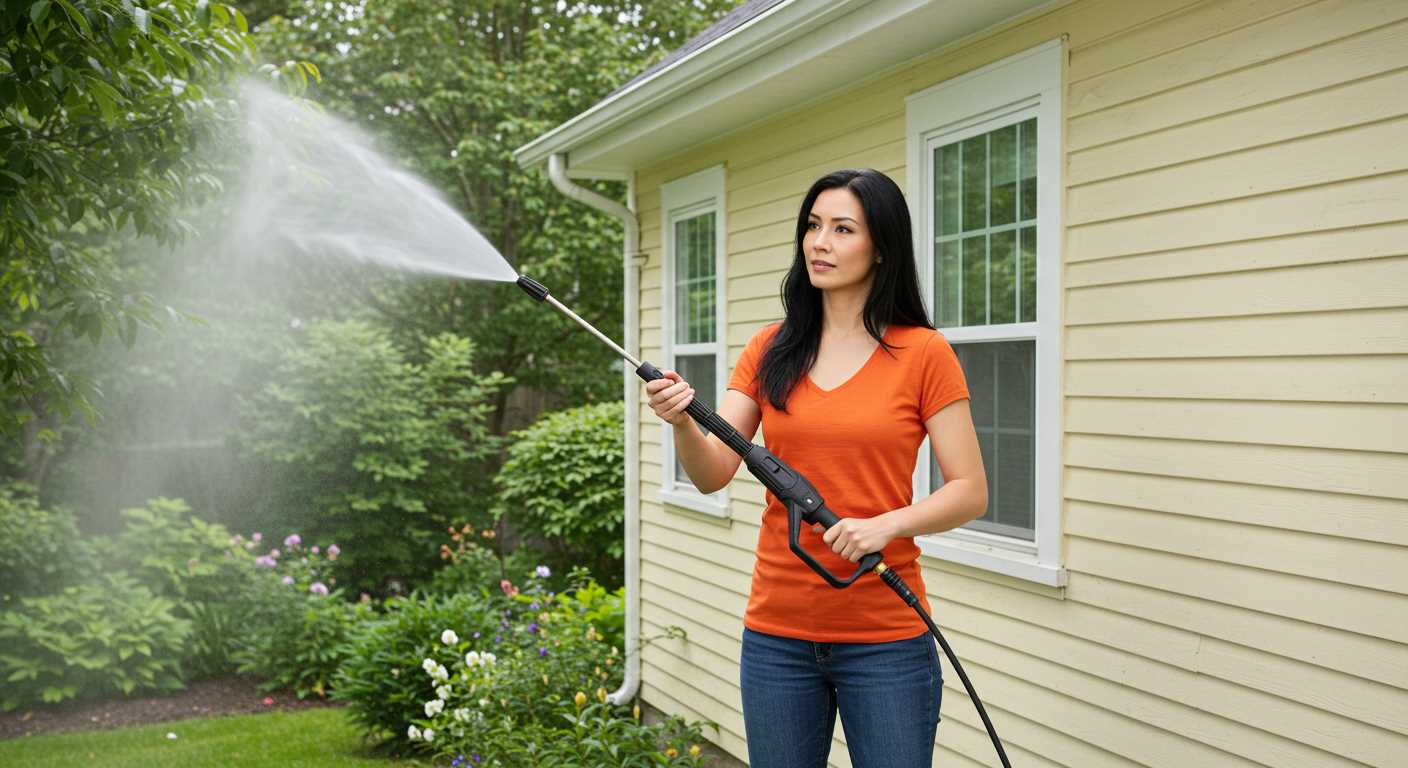



To achieve greater output from your cleaning apparatus, focus on ensuring that the nozzle is clean and unobstructed. A clogged nozzle can significantly diminish performance, preventing the machine from delivering optimal force. Regularly inspect and clean the nozzle using a small brush or needle to remove any built-up debris.
Next, consider utilising a new or larger nozzle. Different nozzle sizes affect the flow rate and force of the water stream. For more challenging tasks, switching to a nozzle that concentrates the spray can enhance cleaning efficiency and power, allowing for better results.
Maintaining the lance and hose is equally important. Check for any leaks or damage that could cause pressure loss. If you find issues, replace worn components promptly to ensure a stable flow. Additionally, make sure that the hose is free from kinks or bends, which can restrict water movement and impact overall performance.
I always recommend verifying the water supply before operating the unit. Use a hose with sufficient diameter to support the flow required by your equipment. Insufficient water supply will limit pressure and effectiveness, negating the potential of your machine.
Lastly, consider the use of appropriate detergents or additives specifically designed for pressure cleaning applications. These products can significantly enhance the cleaning power, allowing you to tackle even the most stubborn stains with ease.
Adjusting Nozzle for Enhanced Output

Swapping out the nozzle can significantly boost the force of the water stream. Choose a nozzle size that corresponds to your cleaning task; narrow nozzles produce a more concentrated jet, increasing impact. For heavy-duty tasks, a 0-degree nozzle can offer maximum pressure, but use it cautiously on surfaces vulnerable to damage.
Inspect for Blockages
Regularly examining your equipment for clogs will ensure optimal performance. Debris can obstruct water flow, diminishing effectiveness. Remove the nozzle and check for any blockages in the hose or pump. Cleaning these components will restore desired power levels.
Increase Water Supply
Ensure that the water source connected to your unit provides an adequate flow rate. Using a larger diameter hose and checking for kinks or leaks can promote improved water delivery. A reliable supply of water contributes to greater output and prevents overheating.
Ensure the pump is functioning correctly. Periodically check the inlet filter as a dirty filter can hinder the machine’s performance. Cleaning or replacing the filter can lead to better water flow and enhanced results.
Focusing on routine maintenance not only extends the life of your machine but also guarantees peak functionality. Ensure your unit is correctly primed before each use to avoid pressure loss.
Understand the Pressure Washer Specifications
Familiarising yourself with the specifications of your cleaning machine is essential for maximising its capabilities. Key aspects include flow rate, measured in litres per minute (LPM), and the cleaning power, expressed in pounds per square inch (PSI). Knowing these figures allows for better adaptation to specific tasks.
Flow Rate (LPM)
- Higher LPM signifies more water delivery. This is particularly advantageous for quickly rinsing surfaces or achieving a thorough clean.
- For intricate tasks or stubborn grime, a lower flow rate paired with higher pressure can be more effective, allowing for concentrated cleaning without excessive water use.
Cleaning Power (PSI)
- PSI indicates how forcefully water is expelled from the nozzle. Units exceeding 2000 PSI are usually effective for heavy-duty jobs, such as removing paint or oil.
- Consider the surface material: softer materials require less force to prevent damage, whereas tougher surfaces can handle higher PSI.
- Always consult your manual for the specific PSI recommended for various surfaces to avoid unintentional harm.
Additional features, including nozzle types and detergent compatibility, also play a role. Adjustable nozzles enable versatile handling, while ensuring your unit is compatible with specific cleaning solutions enhances effectiveness.
Regular maintenance, such as checking for clogs in hoses and tips, helps preserve performance. Staying informed about the capabilities of your machine will lead to better cleaning results and prolonged lifespan.
Check for Clogs in the Hose and Nozzle

Inspect the hose and nozzle for blockages regularly. Debris, grime, or mineral build-up can restrict water flow, significantly impacting efficiency. Start by disconnecting the hose from the machine and the nozzle. Use a flashlight to examine both components thoroughly.
If you encounter any visible obstructions, such as leaves or mud, remove them gently. For tougher clogs, like those from mineral deposits, soak the nozzle in a solution of vinegar and water for several hours. A fine brush can help dislodge stubborn residue without damaging the nozzle.
After ensuring the hose and nozzle are clear, reattach them securely. It’s advisable to run a short test to confirm improved water flow. Should the issue persist, consider cleaning the filters or inspecting internal components for further blockages.
Adjust the Pressure Regulator Settings
To optimise your equipment’s output, locate the pressure regulator, usually found near the motor or pump. It may appear as a knob or lever. Turn it clockwise to elevate the force of the stream. Make minute adjustments and test the results. This way, I’ll fine-tune the performance to suit various tasks.
Be mindful; settings vary across different brands and models. Always refer to the manufacturer’s manual for specific guidance tailored to your model. If the equipment features multiple pressure settings, select the appropriate one for the job at hand. For example, a higher setting works wonders for stubborn stains, while moderate settings suit delicate surfaces.
After modifying the regulator, consistently assess performance. Monitor the output closely; if you notice a drop in effectiveness, it might indicate an issue elsewhere in the system.
Periodically check the regulator for wear. A malfunctioning regulator can compromise output quality, so replace it if needed. Always prioritise safety by using appropriate personal protective equipment during adjustments.
Inspect and Replace Worn or Damaged Parts
Frequent examination of components is essential to maintain optimal functionality. Begin with the high-pressure hose; check for cracks or leaks. A damaged hose can severely reduce the force of the stream.
Components to Inspect
- Nozzle: Ensure it is clean and free from obstructions. A worn nozzle may cause uneven spray patterns.
- O-Rings: Inspect these seals for signs of wear or damage. Replace them if they’re cracked or hardened to avoid leaks.
- Pump: Listen for unusual sounds, as this might indicate internal issues. Inspect for leaks around the pump area.
- Filter: Check the water filter to prevent clogs that could diminish performance.
Should you discover any compromised parts, immediate replacement is advisable. Using worn components not only reduces efficiency but can also lead to more significant repairs down the line. Consult your owner’s manual for specific part numbers and replacement guidance.
Tips for Replacement
- Always use manufacturer-approved parts to guarantee compatibility and performance.
- Follow the instructions closely when replacing any component to ensure proper assembly.
- Consider keeping spare parts on hand for quick maintenance actions.
Consistent upkeep and timely replacements will enhance the longevity of the device and maintain the required performance levels in your cleaning tasks.
Choose the Right Nozzle for Your Task
Selecting the appropriate nozzle is critical for achieving the desired outcome in any cleaning project. Different tasks require distinct spray patterns and pressures, which can profoundly affect the efficiency of your cleaning efforts.
Types of Nozzles
There are typically four main types of nozzles: 0-degree, 15-degree, 25-degree, and 40-degree. The 0-degree nozzle produces a concentrated, powerful jet suitable for tough stains on concrete or brick surfaces, while the 15-degree nozzle is best for stripping paint or tackling heavy grime. The 25-degree nozzle offers a wider spray ideal for general cleaning, such as washing cars or patios. For delicate surfaces, the 40-degree nozzle delivers a gentle mist, perfect for washing windows or wooden decks.
Nozzle Size and Compatibility
Ensure that the nozzle you choose is compatible with your device. Check the specifications of your equipment and select nozzles that fit securely to prevent leaks. Additionally, consider the orifice size; smaller orifices increase pressure but may reduce flow, while larger ones provide more flow at lower pressure. Balancing these factors according to your cleaning needs will optimise performance.
Ensure Proper Water Supply and Connection
Consistent flow and connection quality significantly influence cleaning performance. I recommend a minimum water supply of 7–10 litres per minute for optimal operation. Ensure your source is capable of delivering this rate without interruptions.
Use hoses that are at least 3/4 inch in diameter. This prevents pressure drops and maintains adequate flow to the unit, especially during demanding tasks. I’ve encountered many situations where a thin or damaged hose caused issues.
Check all connections between the water source and the equipment. Look for kinks, leaks, or wear that could restrict flow. A tightly sealed connection is crucial; any leaks can diminish the efficiency of the water supply.
When using an outdoor tap, ensure that it’s fully open. A partially opened tap can significantly reduce water volume. Additionally, consider using a hose filter to prevent sediment from clogging the unit, which can compromise its functionality.
Pay attention to the length of the hose as well. A longer hose may cause pressure losses; keep it as short as necessary to reach the cleaning area. If a longer reach is needed, opt for a professional-grade hose designed for minimal pressure drop.
For the best results, periodically inspect both the water supply and connections. This simple maintenance task ensures that everything functions at peak performance, leading to effective cleaning outcomes.
Clean the Water Filter Regularly
Regularly maintaining the water filter is crucial for optimal performance. A clogged filter restricts water flow, diminishing the effectiveness of the cleaning unit. Check the filter every few uses and clean it as needed. Rinse it under clean water to remove debris, ensuring it’s free of blockages.
Steps for Cleaning
To clean the filter, first, locate it according to the user manual. Remove the filter and inspect it for dirt and buildup. If it appears damaged or too clogged, consider replacing it. A clean filter will significantly improve the water flow rate, leading to superior cleansing results.
Tips for Maintenance

In areas with hard water, sediment can accumulate more quickly. Use a filter designed for hard water situations to minimise mineral buildup. Keeping the filter clean not only enhances the device’s efficiency but also prolongs its lifespan. Regular maintenance checks will keep your equipment running smoothly.
Consider Upgrading Your Pressure Washer Model
If performance is lacking despite your best efforts, it might be time to consider a new model. Investing in a more powerful unit can significantly improve your cleaning capabilities, especially for demanding tasks.
When selecting a new device, pay attention to the specifications, particularly the PSI (pounds per square inch) and GPM (gallons per minute). A higher PSI typically indicates greater force, while increased GPM means more water flow, both critical for effective cleaning.
Here’s a comparison table of different categories of cleaning machines to help guide your decision:
| Model Type | PSI Range | GPM Range | Best Applications |
|---|---|---|---|
| Electric | 1300 – 2000 | 1.2 – 2.5 | Light to moderate cleaning tasks |
| Gas | 2000 – 4000 | 2.5 – 4.0 | Heavy-duty tasks and large surfaces |
| Commercial | 3000 – 5000 | 4.0 – 5.0 | Industrial purposes and professional use |
Choosing a more advanced machine can enhance your efficiency and reduce the time spent on assignments. Just ensure that the model fits your cleaning needs and budget, as high specification equipment often comes with a higher price tag. With the right choice, you will notice a remarkable difference in performance, making your cleaning tasks much more manageable.
FAQ:
What are some common methods to increase the pressure of my pressure washer?
There are several methods to boost the pressure of your pressure washer. First, check the nozzle: a clogged or incorrect nozzle can lower pressure. Switching to a nozzle that suits your cleaning task can improve efficiency. Secondly, inspect your water supply to ensure you’re using sufficient water flow. If the inlet hose is kinked or clogged, it may impede performance. Using a shorter and wider hose can also help. Lastly, adjusting the pressure regulator, if your model allows it, can increase the pressure output.
Can using a different detergent help increase pressure washer performance?
Using the right detergent can enhance your pressure washer’s cleaning power, though it won’t directly increase the water pressure. Some detergents are designed to work with specific pressure washer types and can break down grime more effectively. This means that while your pressure washer operates at the same pressure, the cleaning results can seem more impressive due to the chemical action. Always check the manufacturer’s recommendations for compatible cleaning agents to ensure optimal performance.
How does maintaining my pressure washer contribute to its pressure levels?
Regular maintenance plays a significant role in maintaining the pressure levels of your pressure washer. Over time, dirt and debris can accumulate in the machine, especially around the pump and hoses, which can restrict water flow. Cleaning or replacing filters, checking for blockages, and ensuring that all connections are tight can prevent pressure drops. Maintaining the pump’s oil level and replacing worn seals and O-rings also ensures smooth operation and maintains optimal pressure output.
What impact does the water temperature have on pressure washer performance?
The temperature of the water used in a pressure washer can significantly affect its cleaning ability. Hot water can help break down stubborn stains and grease more effectively than cold water. If your pressure washer is designed for hot water operation, using it at higher temperatures can enhance its cleaning power. However, ensure that your machine is rated for hot water use, as using hot water in a unit designed solely for cold water can cause damage. This adjustment can effectively enhance the perceived cleaning power, even if the actual pressure remains unchanged.








